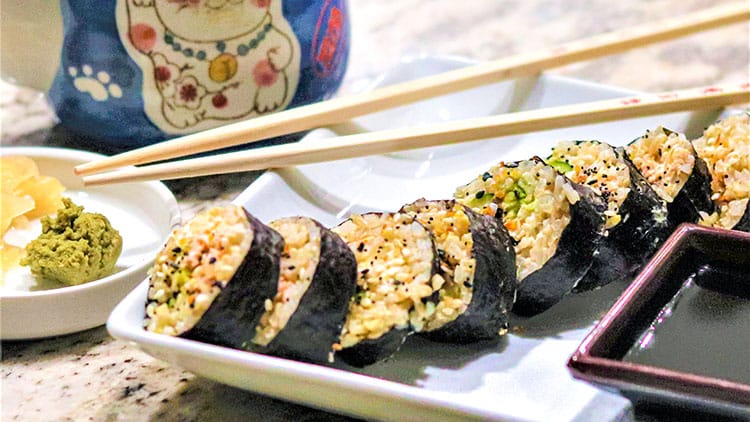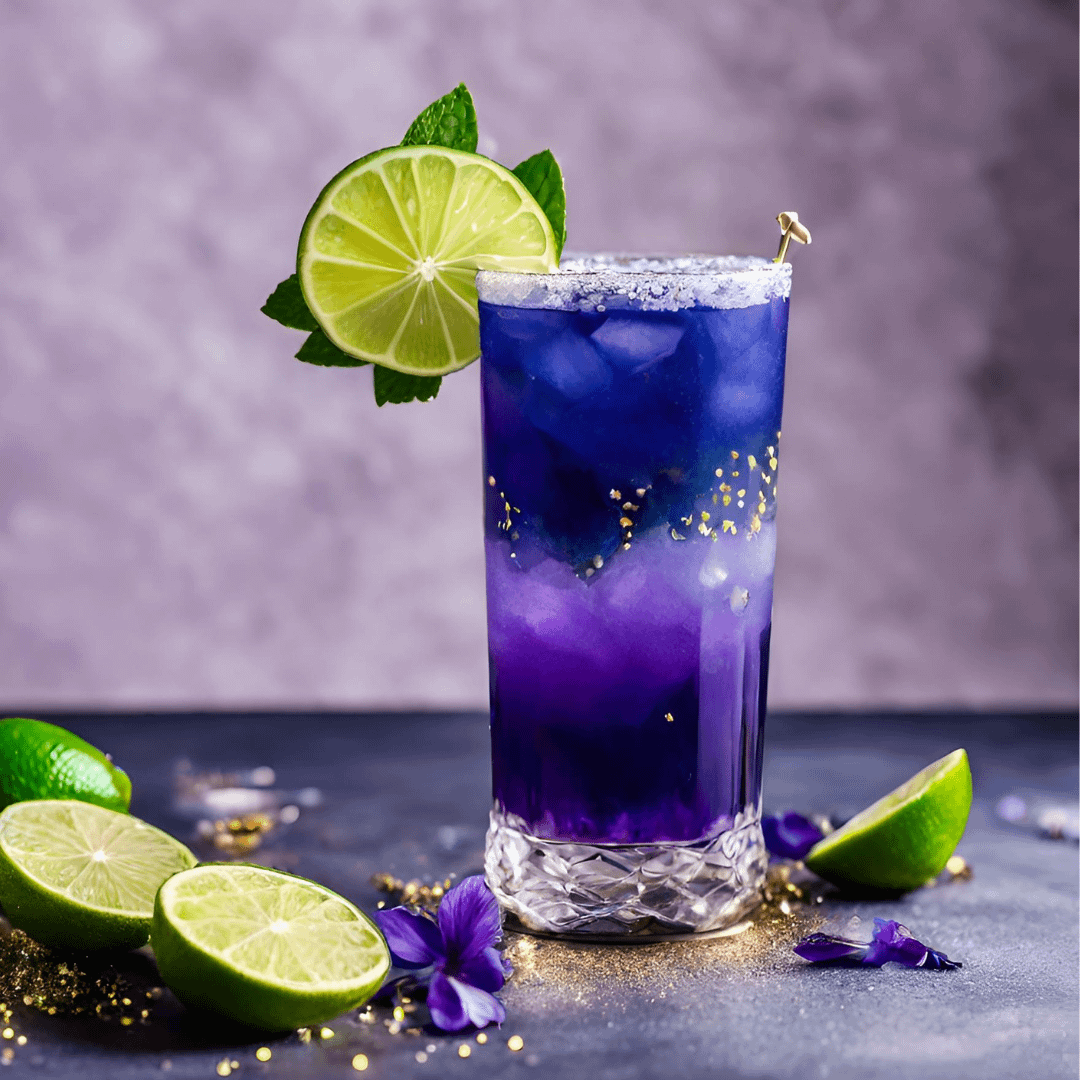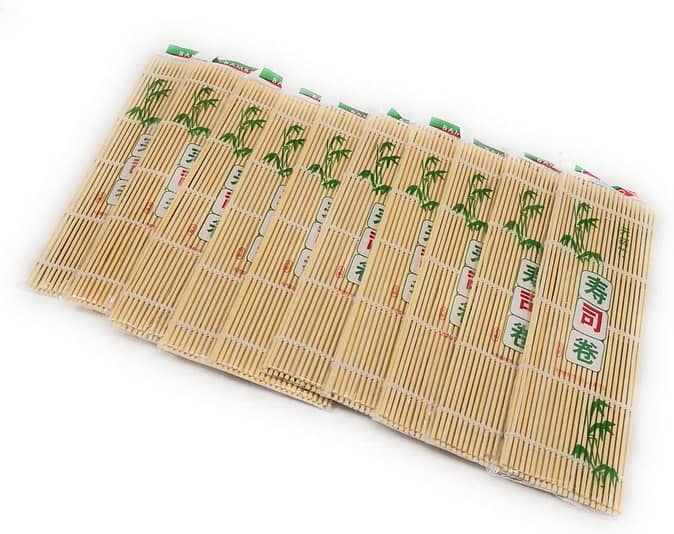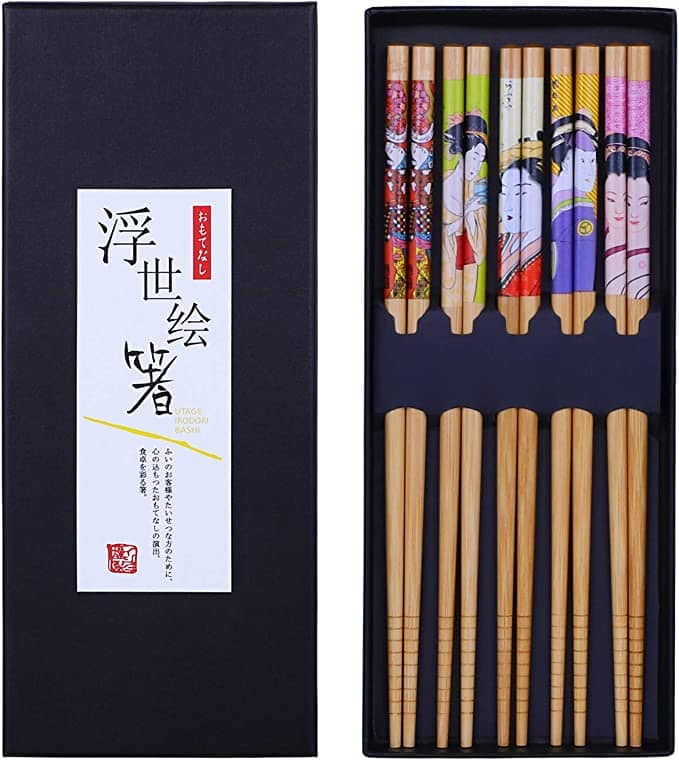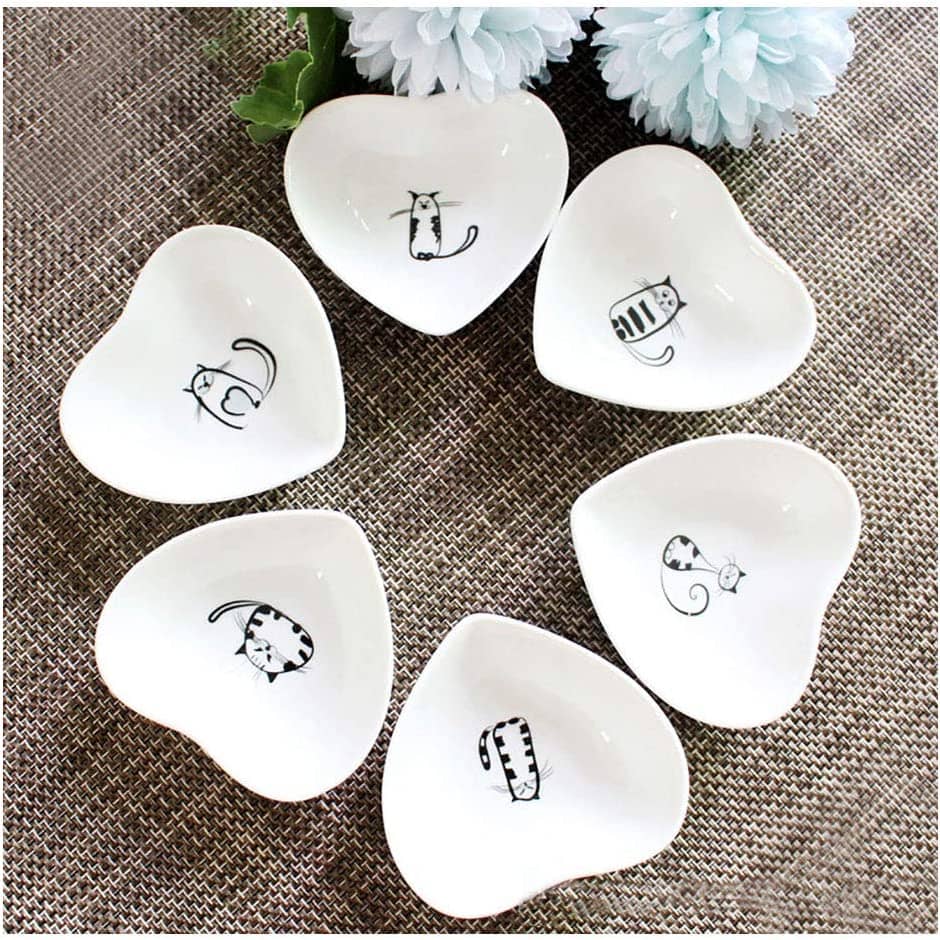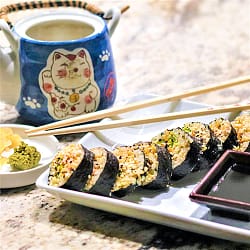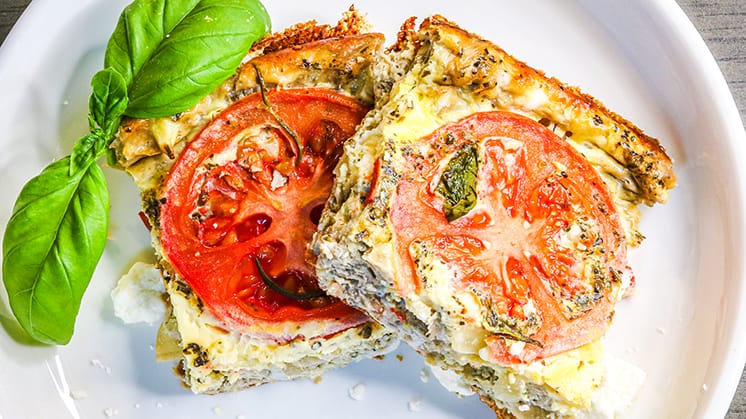Share This

Pages on this site may contain affiliate links, meaning if you book or buy something, I may earn an affiliate commission at no additional cost to you. Thank you for your support! Learn More
Also note: While I am a certified nutrition coach, I am not a medical doctor. Information here is not intended to be a replacement for the advice you should seek from your doctor.
If you’re a sushi lover like me, you’re always looking for a healthier, high-protein alternative to your favorite restaurant rolls. 🍣 Well, look no further! This high-protein sushi recipe is not only lighter and healthier but also quick and simple to make at home.


The key ingredients for this high-protein sushi include short-grain brown rice, rice vinegar, nori sheets, your choice of veggies, and a source of low-fat protein. You might wonder where the sugar is for prepping the sushi rice—good news, you don’t need it! Using the right type of brown rice and vinegar will help you make completely sugar-free rice sushi.
These light and healthy sushi rolls are lower in carbs and higher in protein than regular sushi. The trick is to limit the amount of rice and substitute it with more veggies and a lean protein source. Making your own sushi allows you to choose the best ingredients and quantities. Plus, rolling sushi can be a fun activity for family or friends. 🎉 Check out this video tutorial on how to roll sushi even without a bamboo mat!
Excited to make this high-protein sushi? Here are the best ingredients and a few extra tips to get you started!
High-Protein Sushi: The Best Ingredients!
Choosing the right ingredients is crucial for making light and healthy sushi. Here are my favorite ingredients and suggestions for increasing the protein content of your rolls.
1. Skip the Sugar in Your Sushi Rice 🍙
Forget about adding sugar to your sushi rice! This recipe includes only rice, rice vinegar, and salt, resulting in sticky, moldable rice perfect for sushi rolls. Using short-grain brown rice increases fiber, helping you feel fuller longer with less rice.
I recommend using these premium quality nori sheets, which are rich in iodine and easy to use.
2. Don’t Forget Your Veggies 🍅
Fill your rolls with colorful veggies like cucumbers, beets, asparagus, sweet potatoes, carrots, avocado, and mango. These add nutrition and allow you to eat more for fewer calories.
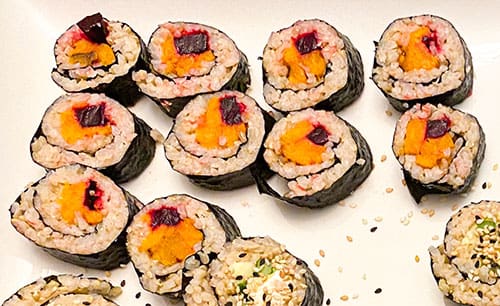

❤️❤️ Don’t miss a recipe or post! Make sure you remember to sign up for my Newsletter and follow me on social ❤️❤️!
Get Your Free Stuff!
3. Choose a Source of Lean Protein 🐟
Protein is the star of this high-protein sushi! Opt for lean, low-fat protein sources like tempeh, tofu, canned salmon or tuna, steamed shrimp or crab, or sushi-grade fish. Light cream cheese or finely sliced egg frittata can also work well.
Plant-Based Proteins
Choosing plant-based protein sources for your sushi offers numerous health and environmental benefits. Plant-based proteins such as tempeh, tofu, and seitan are not only rich in protein but also provide essential nutrients like fiber, vitamins, and minerals that are often lacking in animal-based proteins. Additionally, incorporating plant-based proteins like edamame, chickpea “tuna,” and mushrooms can diversify your diet and introduce new, exciting flavors and textures to your meals. From an environmental perspective, plant-based proteins have a lower carbon footprint compared to traditional fish and meat, making them a more sustainable choice. Moreover, for those concerned about mercury levels and overfishing in seafood, plant-based options present a safer and more ethical alternative. Embracing these ingredients in your sushi not only supports your health and well-being but also contributes to a more sustainable and compassionate food system.
| Protein Source | Protein Content (per 100 grams) |
|---|---|
| Tempeh | 19 grams |
| Seitan | 19 grams |
| Tofu | 8 grams |
| Light Cream Cheese (Neufchâtel) | 8 grams |
| Edamame | 11 grams |
| Chickpea “Tuna” | 8 grams |
| Mushrooms (e.g., Shiitake or Portobello) | 3 grams |
| Avocado | 2 grams |
| Vegan “Fish” | Varies, typically 10-15 grams |
Animal-Based Proteins
When buying sushi-grade fish, it’s essential to ensure you’re getting the highest quality to ensure safety and taste. Look for a reputable fishmonger or seafood market known for their fresh products. Ask if the fish is labeled as “sushi-grade” or “sashimi-grade,” which means it has been frozen to kill any parasites and is safe to eat raw. Examine the fish for clear, bright eyes and shiny skin; it should smell like the ocean, not fishy. Always buy fish from a trusted source, and if you’re uncertain, don’t hesitate to ask the seller about the fish’s origin and handling process. Keeping the fish refrigerated or on ice and consuming it promptly after purchase is crucial to maintain its freshness and safety.
If you’re looking for more affordable options, you can still enjoy making sushi with some budget-friendly alternatives:
- Frozen Fish: Many grocery stores sell frozen fish that can be used for sushi. Freezing fish at very low temperatures can kill parasites. Look for high-quality frozen fish and thaw it safely in the refrigerator.
- Canned Fish: High-quality canned fish like tuna can be a great affordable option for sushi rolls.
- Cooked Fish: Use fish that has been cooked thoroughly, such as grilled salmon or seared tuna, in your sushi rolls.
- Smoked Fish: Smoked salmon is a popular choice and is often more affordable than fresh sushi-grade salmon. It’s already cured and ready to eat.
- Farmed Fish: Farmed fish, such as Atlantic salmon, is generally more affordable than wild-caught fish. Ensure it’s fresh and handle it with care.
Tips for Using Non-Sushi Grade Fish:
- Freeze the Fish: If you buy fresh fish, freeze it for at least 7 days at -4°F (-20°C) to kill parasites. This method is used by many sushi chefs to ensure safety.
- Cook the Fish: If you’re unsure about the safety of consuming raw fish, consider cooking it. Grilled, baked, or lightly seared fish can still make delicious sushi.
- Marinate the Fish: Marinating fish in acidic solutions like vinegar or lemon juice can help reduce the risk of bacteria and add flavor.
- Choose Fresh Fish: Buy the freshest fish available from a trusted source. Look for fish with clear eyes, firm flesh, and a fresh sea smell.
- Practice Good Hygiene: Always handle fish with clean hands and utensils. Keep your preparation area clean and avoid cross-contamination with other foods.
Using these methods, you can enjoy making sushi at home more affordably while still prioritizing safety.
| Protein Source | Protein Content (per 100 grams) |
|---|---|
| Canned Tuna | 25 grams |
| Steamed Shrimp | 24 grams |
| Sushi-Grade Fish | 20-25 grams |
| Canned Salmon | 20 grams |
| Smoked Salmon | 18 grams |
| Tuna (Maguro) | 20-25 grams |
| Salmon (Sake) | 20-25 grams |
| Yellowtail (Hamachi) | 20-25 grams |
| Eel (Unagi or Anago) | 20 grams |
| Crab (Kani) | 20 grams |
| Octopus (Tako) | 19 grams |
| Squid (Ika) | 18 grams |
| Scallops (Hotate) | 17 grams |
| Crab (Imitation) | 6 grams |
4. The Best Garnishes 🧄
Top your sushi with healthy garnishes like kimchi or pickled ginger. These fermented foods are rich in pre and probiotics, promoting a healthy digestive system. If you prefer, use a low-sodium soy sauce or wasabi powder.
A Great Party or Family Activity As Well!
My kids absolutely love sushi, and they have gotten better at rolling them. Since we have a lot of kids, its a lot more economical (and serves as a night of entertainment) to roll the sushi with them. I just love setting up cultural food activities with my kids. It’s great to expose your kids to adventurous and healthy meals.
It also made for one of our best parties with friends to date! Just make sure you remember to offer gloves and each person their own bowl of water for sanitation reasons.


Add Some Great Asian Sides
- Steamed Edamame with rock salt and/or chili flakes (this is an excellent plant-based protein source!)
- A side salad with my honey ginger dressing
- Asian Slaw with Sweet and Spicy Peanut Dressing 🥜
- Spicy Mushroom Noodles with Thai Eggplant and Bok Choy
High-protein Sushi: the best accessories 🥢
Finally, here are some of the best accessories for making your own high-protein sushi rolls at home! 🍣 Obviously, you can easily replicate my recipe even without them (here is a YouTube video that explains step-by-step how to roll the sushi without a bamboo mat).
1. Sushi Rolling Mats
I love these bamboo mats, as they are very pretty and easy to use. I love to give one to each of my guests and invite them to create their own sushi rolls. Perfect for a sushi party or also a fun night with your kids!
2. Reusable Bamboo Chopsticks
Have you ever seen prettier chopsticks? I bet not! Plus, they are made with natural materials and are very easy to wash and simple to use, thanks to their non-slip design. To sum up, they are perfect if you are using chopsticks for the first time!
3. Tojiro Japan Professional Chef’s Knife
Having a sharp knife is imperative for good sushi. I actually have this knife and have been using it for most of my chopping for several years now!


3. Ceramic Side Sauce Dishes
These cat-shaped sauce dishes are perfect for displaying all of your side sauces and garments. This way, your guests will always have their favorite condiments at hand! Plus, they are made of ceramic and are also safe to use in the microwave.
With this in mind, you are ready to make your own high-protein sushi rolls at home! In case you try it, let me know how it went down below in the comments. Finally, don’t forget to follow my socials for new healthy recipes. All the links are down below! 💗
High Protein Sushi
Ingredients
For the sushi rice:
- 2 ½ cups Short-grain brown rice
- ¼ cup Rice vinegar
- 1 ¼ tsp Salt
For the fillings:
- Nori sheets
- Veggies (sweet potato, beet, asparagus, cucumber, avocado, carrots, mango, etc.)
- Light cream cheese
- Tofu (presoak in a little sesame oil, soy sauce, and rice vinegar) or tempeh
- Fish (steamed shrimp, canned tuna or salmon, crab, sushi grade fish)
- Wasabi, soy sauce, sriracha, pickled ginger optional
Instructions
For the sushi rice:
- Prepare the short-grain brown rice according to the package. A little softer is better and I like to use the instant pot for this.
- Mix in 1/4 cup rice vinegar and 1 1/4 tsp salt.
- Let it rest until the rice is cool and malleable.
Prepare the Ingredients:
- Lay out your bamboo sushi mat on a clean surface. You can cover it with plastic wrap for easier cleaning.
- Place a sheet of nori on the mat, shiny side down.
Spread the Rice:
- Wet your hands to prevent the rice from sticking. Take a handful of sushi rice and spread it evenly over the nori, leaving about a 1-inch border at the top edge of the nori sheet.
- Press the rice gently but firmly to ensure it sticks to the nori.
Assemble everything, choosing from the fillings above.
- Place your fillings in a line across the rice, about 1 inch from the bottom edge of the nori. Be careful not to overfill.
Roll the Sushi:
- Start rolling from the bottom edge where the fillings are. Use your thumbs to lift the edge of the mat while holding the fillings in place with your fingers.
- Roll the mat forward, pressing gently but firmly to shape the roll.
- Continue rolling until you reach the top border of the nori. Wet the exposed edge of the nori with a little water to seal the roll.
Cut the Sushi:
- Use a sharp knife to cut the roll into bite-sized pieces. To make clean cuts, dip the knife in water between cuts.
Serve:
- Arrange the sushi pieces on a plate and serve with soy sauce, wasabi, and pickled ginger.
- Enjoy your healthy sushi!
Notes
Tips:
- Keep a bowl of water nearby to dip your fingers in while handling the rice.
- Use fresh, high-quality ingredients for the best flavor.
- Practice makes perfect; don’t be discouraged if your first few rolls aren’t perfect.

